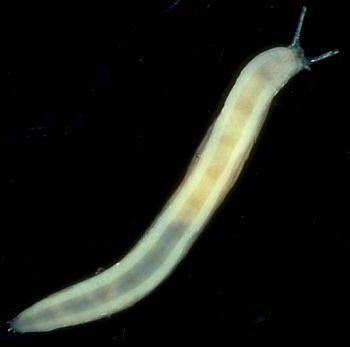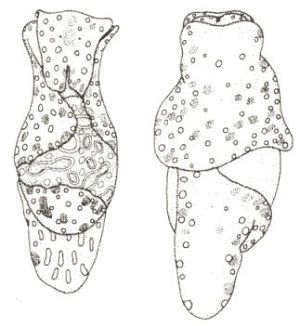

How sea slugs crawl
PHOTO
Upper: Sole of land slug Limax gagates [55mm long] showing tranverse bands of contracted muscle.
Lower: Haminoea cymbalum showing posterior 'pseudofoot'. Photo & Drawings: Bill Rudman.
Most gastropods (marine snails, land snails and slugs, and sea slugs) have a muscular foot which is used from crawling. The foot produces a sticky mucus and has a coating of fine cilia. Some very small snails seems to slide along on their mucous secretion simply by the beating of their cilia, but in most gastropods transverse waves of muscular contraction move along the foot, from the posterior to the anterior end. These waves form temporary points of attachment which effectively pull the snail/slug along. I have included a photo of the foot of a land slug, Limax gagates from my garden. It clearly shows the foot is a complex structure with a thick band around the edge which remains in permanent contact with the ground and a median band which only makes contact as the transverse wave of contraction moves past. The darker bands are the waves. The nature of the wave differs in different families, some have waves right across the foot, others have the foot divided down the middle with an alternate left and right wave travelling along the foot. One of life's little mysteries is why the silvery trails on the footparh are sometimes continuous and sometimes a series of patches. You can see that this slug is always in contact with the ground so it is responsible for a continuous trail while the common garden snail Helix aspersa, which doesn't have a permanent muscle band around the edge, produces a dotted trail.
Before I forget that this is a Sea Slug Forum, lets look at them in particular. Most nudibranchs have a muscular foot which can be modified for particular situations. In species which live on soft sand, like Cerberilla the foot is very broad and ciliary gliding predominates over muscular waves, while in large dorids forward movement is almost totally dependent on the wave of muscle contraction. Many animals which live in potentially perilous places, such as a branching hydroid or alga in a strong current, have specialised pedal glands which produce a particularly sticky mucus so they retain a hold on their substrate.
In many cephalaspid bubble shells the true foot is lost or very reduced, and they have a secondary foot developed from the posterior mantle flap. Species of Haminoea show a half-way situation [see drawing above]. In the aglajids this secondary foot is apparently all that is present, and in aglajids [Chelidonura, Philinopsis etc] locomotion is totally produced by ciliary gliding on a bed of mucus produced by enormous glands at the anterior end. Some sacoglossans have a transverse groove across the foot just behind the head, suggesting to me that the part of the foot behind the groove is also a secondary foot.
One side-effect of producing a mucous trail is that nudibranchs, and other sea slugs advertise their whereabouts at all times. Carnivores such as Navanax inermis and species of Roboastra rely on this tell-tale trail to find their prey. It is also apparently useful in the peculiar 'trailing' behaviour of species of Risbecia.
Some sea slugs swim. This behaviour has evolved independently many times within the opisthobranchs. When I get a chance I will prepare a separate page on swimming.
Authorship detailsRudman, W.B., 2001 (May 23) How sea slugs crawl. [In] Sea Slug Forum. Australian Museum, Sydney. Available from http://www.seaslugforum.net/factsheet/locomotion
Related messages
-
Detecting slime
From: Laura Richards, September 26, 2002 -
Re: Snail's slime
From: Cynthia Trowbridge, June 26, 2002 -
Snail's slime
From: Earl Denzel Perez, June 25, 2002 -
How does a nudibranch foot work?
From: Valda Fraser, May 25, 2001
